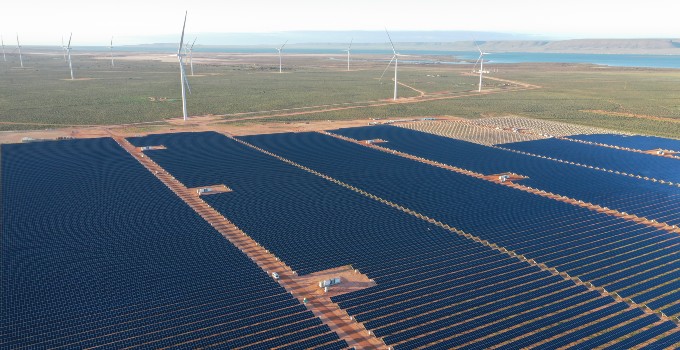Port Augusta Renewable Energy Park

Client: Iberdrola
Location: South Australia, Australia
Date: 2022 - 2023
Providing hold point testing, GPS compliance assessment and R2 model validation for Australia's biggest hybrid wind and solar farm
Background
Grid connection of hybrid energy parks is a vital stage in any electricity project’s progress. As more multi-technology power plant developments emerge, successful grid connection will help facilitate greater proportions of renewable energy across the nation, helping Australia reach our clean energy targets and net zero goal.
One such park is the Port Augusta Renewable Energy Park (PAREP), located approximately 8 km east of Port Augusta, South Australia. It comprises 50 x 4.2 MW Vestas wind turbines, 2 x 15 MVAr static synchronous compensators (STATCOM) and 36 x 2.75 MVA solar PV inverters with a combined capacity of 270 MW at the point of connection (POC).
Iberdrola engaged Entura to provide support to meet regulatory requirements around hold point testing, GPS compliance assessment and R2 model validation to enable 270 MW of renewable energy generation to enter the National Electricity Market (NEM).
Solution
Entura developed and finalised the test procedure for the hybrid wind and solar farm’s hold point testing and R2 model validation phases. We synthesised the client’s specific requirements with those of the Australian Energy Market Operator (AEMO) – a key foundation for the project’s future success. By mapping out a clear pathway and acceptance criteria for individual hold points, Entura ensured expectations of the project’s regulatory stakeholders were managed throughout the project.
Entura conducted pre-test simulations for the newly added solar farm as well as the hybrid plant including all generation. These simulations confirmed that the expected solar farm and overall PAREP responses were safe and likely to meet performance requirements. This also acted as a risk identification tool by indicating where heightened operation attention would be required during actual testing. Prior to testing, Entura prepared load profiles and test schedules, which resulted in smooth, efficient and timely completion of each hold point test.
Our experience in this area and extensive catalogue of relevant tools allowed for time-efficient and high-quality analysis of test data and assessment of compliance with generator performance standards (GPS). Entura seamlessly delivered appropriate checks and compliance assessments for each hold point, allowing PAREP to increase generation output for the next hold point level.
Entura’s pragmatic approach included preliminary model overlays at each hold point rather than undertaking all model overlays at the R2 stage later in the project. This ensured that any emerging challenges around model accuracy were identified early. Our approach facilitated smooth progress through individual hold point testing, with the full model validation undertaken during the R2 phase.
Services provided
- Test procedure development
- Pre-test simulations
- Load profiles and test schedules
- Hold point testing
- Generator Performance Standards (GPS) compliance assessments
- R2 model validation
Outcomes
Entura’s expertise and experience in GPS compliance assessments and model validation were key to delivering this project, which builds on our strong record of delivering high-quality work and meeting all regulatory requirements.
The R2 model validation report compiled by Entura clearly outlined PAREP model performance demonstrating satisfactory performance and accuracy aligned with AEMO’s power system modelling guidelines. It also incorporated additional comments and recommendations for model improvements identified by preliminary model overlays at hold point level.
Close collaboration between Iberdrola and Entura throughout the hold point testing and R2 model validation phases ensured that the Port Augusta Renewable Energy Park gained approval for commercial operation at full output in early 2023. PAREP’s clean energy generation is expected to be enough to supply the annual demand of 180,000 Australian households, helping to accelerate the decarbonisation of South Australia’s economy.


